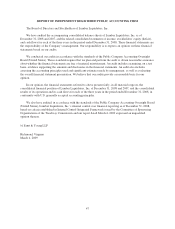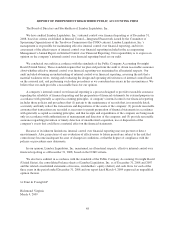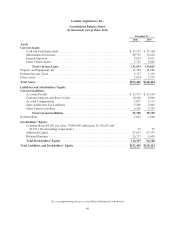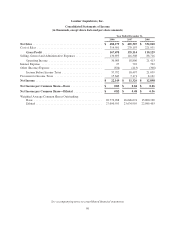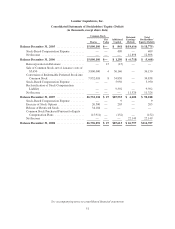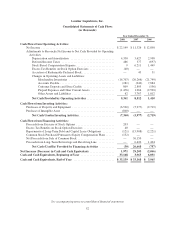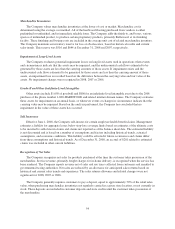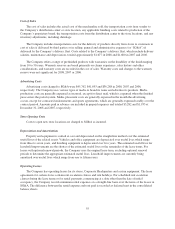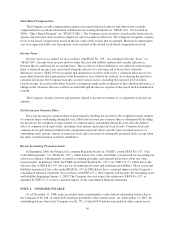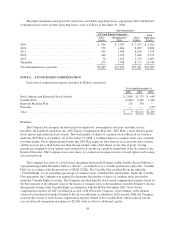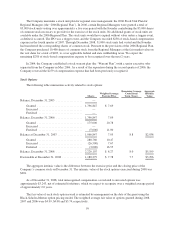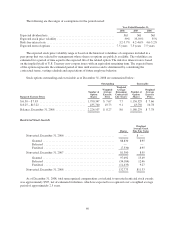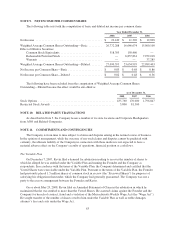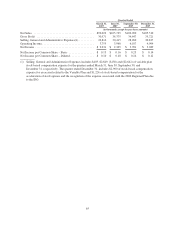Lumber Liquidators 2008 Annual Report Download - page 62
Download and view the complete annual report
Please find page 62 of the 2008 Lumber Liquidators annual report below. You can navigate through the pages in the report by either clicking on the pages listed below, or by using the keyword search tool below to find specific information within the annual report.Stock-Based Compensation
The Company records compensation expense associated with stock options and other forms of equity
compensation in accordance Statement of Financial Accounting Standards (or “SFAS”) No. 123 (revised in
2004), “Share-Based Payment” (or “SFAS 123(R)”). The Company issues incentive awards in the form of stock
options and restricted stock awards to employees and non-employee directors. The Company recognizes expense
for its stock-based compensation based on the fair value of the awards that are granted. Measured compensation
cost is recognized ratably over the requisite service period of the related stock-based compensation award.
Income Taxes
Income taxes are accounted for in accordance with SFAS No. 109, “Accounting for Income Taxes” (or
“SFAS 109”). Income taxes are provided for under the asset and liability method and consider differences
between the tax and financial accounting bases. The tax effects of these differences are reflected on the balance
sheet as deferred income taxes and valued using the effective tax rate expected to be in effect when the
differences reverse. SFAS 109 also requires that deferred tax assets be reduced by a valuation allowance if it is
more likely than not that some portion of the deferred tax asset will not be realized. In evaluating the need for a
valuation allowance, the Company took into account various factors, including the expected level of future
taxable income. If actual results differ from the assumptions made in the evaluation of the valuation allowance, a
change in the valuation allowance will be recorded through income tax expense in the period such determination
is made.
The Company classifies interest and penalties related to income tax matters as a component of income tax
expense.
Net Income per Common Share
Basic net income per common share is determined by dividing net income by the weighted average number
of common shares outstanding during the year. Diluted net income per common share is determined by dividing
net income by the weighted average number of common shares outstanding during the year, plus the dilutive
effect of common stock equivalents, including stock options and restricted stock awards. Common stock and
common stock equivalents included in the computation represent shares issuable upon assumed exercise of
outstanding stock options, release of restricted stock and conversion of redeemable preferred stock, except when
the effect of their inclusion would be antidilutive.
Recent Accounting Pronouncements
In September 2006, the Financial Accounting Standards Board (or “FASB”) issued SFAS No. 157, “Fair
Value Measurements” (or “SFAS No. 157”), which defines fair value, establishes a framework for measuring fair
value in accordance with generally accepted accounting principles and expands disclosures about fair value
measurements. In February 2008, the FASB issued Staff Position No. 157-2 (or “FSP 157-2”) which delays the
effective date of SFAS No. 157 one year for all nonfinancial assets and nonfinancial liabilities. Those assets and
liabilities measured at fair value under SFAS No. 157 in 2008 did not have a material impact on the Company’s
consolidated financial statements. In accordance with FSP 157-2, the Company will measure the remaining assets
and liabilities beginning January 1, 2009. The Company does not expect the adoption of SFAS No. 157, as
amended by FSP 157-2, to have a material impact on the consolidated financial statements.
NOTE 2. NOTES RECEIVABLE
As of December 31, 2008, notes receivable from a merchandise vendor had an outstanding balance due to
the Company of $1,168, of which $251 had been included in other current assets. As of December 31, 2007, the
outstanding balance due to the Company was $1,375, of which $519 had been included in other current assets.
56



